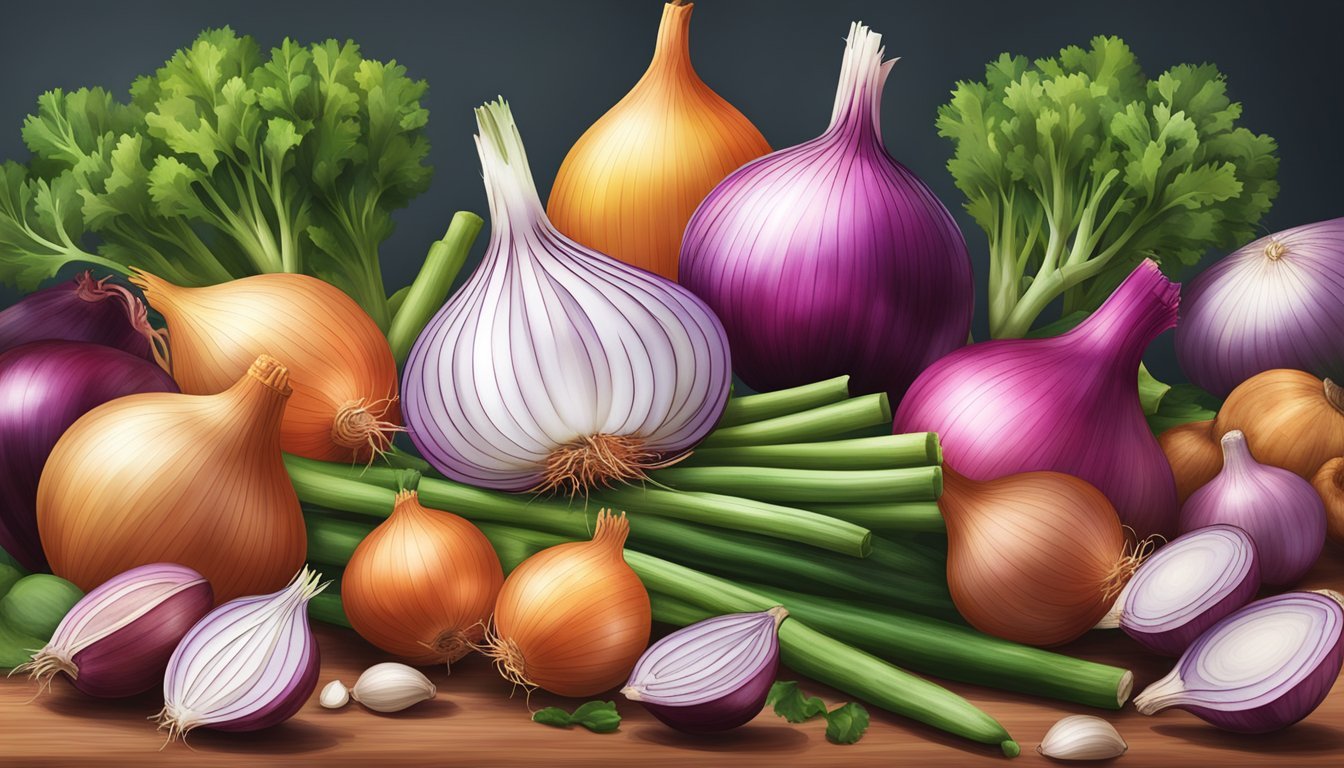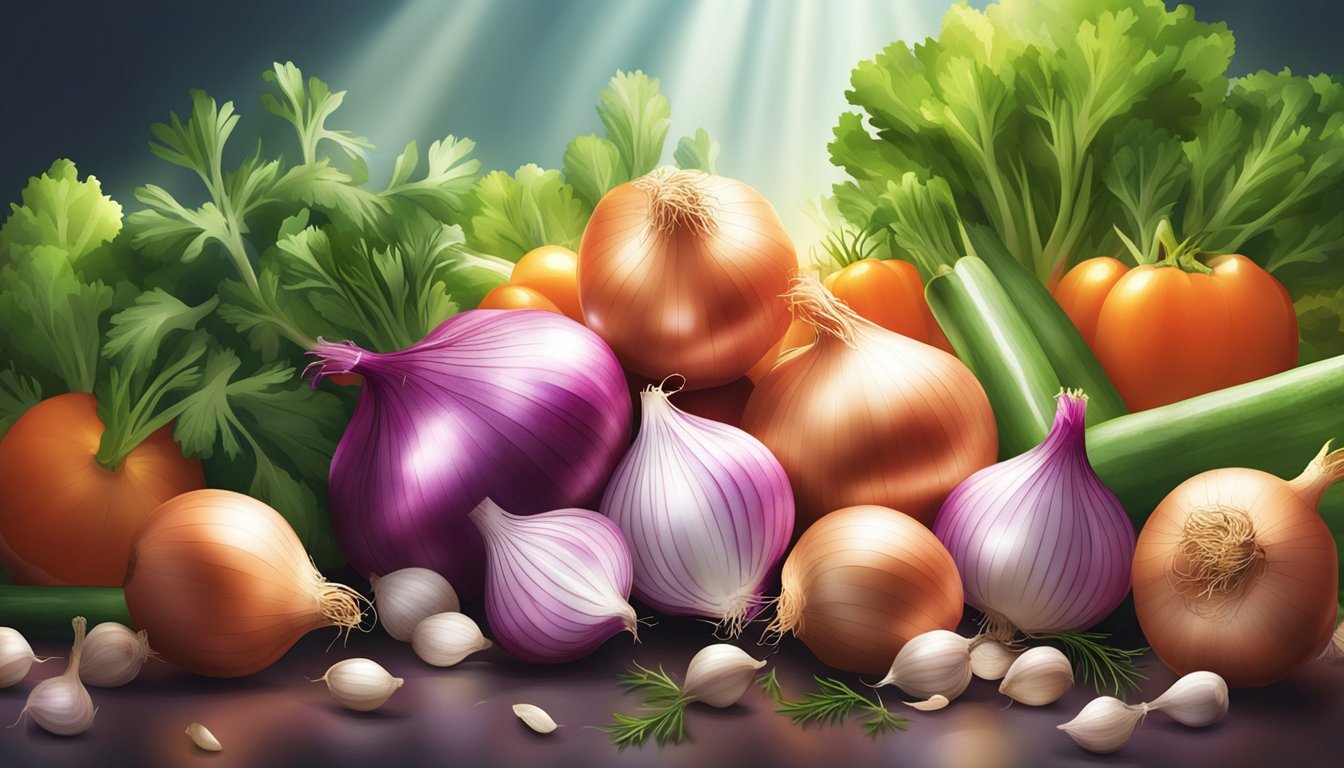What Are the Health Benefits of Shallots?
Exploring Nutritional Advantages
Shallots, a type of onion with a milder taste and a hint of garlic, are rising in popularity not just for their culinary versatility but also for their health benefits. These small, bulbous vegetables belong to the allium family, which is known for containing health-promoting compounds. Along with their distinct flavor, shallots are packed with vitamins, minerals, and antioxidants, making them beneficial for a wide array of bodily functions and protective against certain diseases.
Among the key health benefits of shallots is their high content of antioxidants such as quercetin and kaempferol. These compounds play a vital role in reducing inflammation and combating free radical damage, which are linked to chronic diseases. Shallots are also a good source of vitamin A and vitamin C, which are essential for healthy skin and immune function, respectively. Moreover, the presence of allicin, a sulfur-containing compound found in allium vegetables, has been associated with improved cardiovascular health and possesses antimicrobial properties.
The mineral content in shallots should not be overlooked, as they provide a good source of elements like selenium. Selenium plays a crucial role in maintaining healthy immune and cognitive functions, as well as metabolism. Incorporating shallots into a balanced diet could therefore contribute to overall wellness and disease prevention, capitalizing on their nutritional profile that supports physical health.
Nutritional Profile of Shallots
Shallots (Allium cepa var. aggregatum) are a valued food ingredient not only for their distinctive flavor but also for their nutrient-rich profile. They provide a unique combination of vitamins, minerals, and antioxidants that contribute to their health benefits.
Vitamins and Minerals
Shallots contain a variety of vitamins and minerals essential for the body's functioning. They are particularly high in vitamin B6 and folate, which play crucial roles in energy metabolism and the formation of red blood cells. Besides these, shallots offer moderate amounts of vitamin C, potassium, and manganese, nutrients important for immune function, blood pressure regulation, and bone health, respectively.
Vitamin B6: Supports metabolism and cognitive development
Folate: Important for DNA synthesis and cell growth
Vitamin C: An antioxidant that is vital for skin health and immunity
Potassium: Regulates fluid balance and supports heart function
Manganese: Involved in bone formation and amino acid metabolism
Shallots also provide calcium, iron, and a small amount of copper and magnesium, which collectively support bone health, oxygen transport, enzyme activity, and nerve function.
Antioxidants and Phytochemicals
Shallots are a rich source of antioxidant compounds that protect the body from oxidative stress. Among them, kaempferol is a noted flavonoid that contributes to the anti-inflammatory and cardioprotective effects of shallots. Other antioxidants include quercetin and sulfur-containing compounds that help neutralize harmful free radicals.
Kaempferol: Linked to reduced risk of chronic diseases
Quercetin: Supports cardiovascular health and may reduce inflammation
Sulfur-containing Compounds: Potentially boost detoxification processes in the body
These antioxidants, together with other phytochemicals found in shallots, may play a role in diminishing the risk of several health conditions, including some forms of cancer and cardiovascular diseases. Comparatively, shallots contain higher levels of these phytochemicals than their relative, the common onion.
Health Advantages of Shallots
Shallots, an allium vegetable, are recognized for their ability to positively affect various aspects of health, including cardiovascular health, cancer prevention, and glucose management. They provide a range of antioxidants and compounds such as quercetin and allicin, which contribute to their notable health benefits.
Cardiovascular Health
Shallots contain flavonoids like quercetin, which play a role in heart health by helping to reduce inflammation and prevent blood clots. Regular consumption of shallots may lead to lower blood pressure and improved circulation, both of which are crucial factors in minimizing the risk of heart disease.
Cancer Prevention
Due to their high antioxidant content, including compounds like phenols, shallots can help neutralize free radicals in the body, potentially reducing the risk of cancer. These antioxidants also exhibit antibacterial and antiviral properties, enhancing the body's resistance to various diseases.
Blood Sugar and Diabetes Management
The inclusion of shallots in the diet might aid in management of blood sugar levels due to their potential to improve insulin sensitivity. For individuals with diabetes or those at risk, shallots can be a valuable dietary addition for maintaining stable blood glucose levels.
Skin and Bone Health
Shallots are a source of vitamins, such as vitamin C and vitamin A, which are essential for maintaining healthy skin and promoting bone density. The trace element selenium, found in shallots, contributes to the health of the skin by protecting cells from oxidative stress and aging.
Culinary Uses and Dietary Integration
Shallots are prized for their unique flavor that adds depth to various dishes and their ability to seamlessly integrate into a wide range of diets. Rich in nutrients and versatile in cooking, they offer more than just culinary flair.
Incorporating Shallots into Your Diet
Shallots can be introduced into one's diet in myriad ways, given their ease of preparation and compatibility with numerous ingredients. They stand out not only for their distinctive, mild flavor, which is less harsh than that of yellow onions (What wine goes well with onions?) or garlic, but also for their healthful properties, including the presence of flavonoids like kaempferol. To increase their dietary presence:
Raw: Finely chopped shallots add a subtle zing to salads and dressings.
Roasted: Roasting brings out their natural sweetness, making them an excellent addition to vegetable medleys.
Sautéed: Sauté shallots as a base for sauces, soups, and stews to enhance complexity.
Pickled: Pickled shallots offer a vibrant sour note to sandwiches and salads.
By incorporating shallots into meals, individuals can enjoy not only their unique taste but also their potential health benefits due to their low carbohydrate content and valuable nutrients.
Culinary Versatility of Shallots
In the culinary world, shallots are highly regarded across Asia and other cuisines for their adaptability and ability to elevate a dish. Chefs frequently use shallots when a milder onion flavor is desired. Their application in cooking encompasses a broad range of techniques:
Sauces: Shallots are the backbone of many classic sauces, especially in French cuisine, where they're finely diced for delicate textures.
Salads and Dressings: They lend a more refined flavor than stronger onions or garlic.
Soups: Shallots enrich broth-based soups with a subtle depth.
Asia-Inspired Dishes: Many Asian recipes call for shallots as they are a foundational element, particularly in stir-fries and fried rice.
Different from leeks, chives, and scallions in both flavor and texture, shallots provide cooks with a distinctive option for creating meals that are as nutritious as they are flavorful. Whether utilized in their various forms or as a primary ingredient in a shallot-focused recipe, their culinary uses are as diverse as they are impactful.
Comparative Analysis of Allium Family
Shallots, onions, and garlic share a family lineage being part of the Allium genus, known for its species that are highly valued both in culinary and medicinal contexts. Each member of this family brings a distinctive set of characteristics and health benefits to the table.
Similarities with Onions and Garlic
The Allium family, which includes shallots (Allium ascalonicum), onions (Allium cepa), and garlic (Allium sativum), is unified by the presence of sulfur compounds that are the main contributors to their pungent flavors and potential health benefits. These compounds are thought to possess antimicrobial, anti-inflammatory, and antioxidant properties that can contribute to reducing the risk of various diseases such as cancer and cardiovascular disease. Allium vegetables are also recognized for their fiber content and the presence of polyphenols.
Commonly to garlic and onions, shallots are used to roast, mince, and cook, serving as a foundational flavor in many dishes. They also share historical uses as traditional medicines across cultures and are considered to be beneficial for a range of health concerns including heart health and diabetes management.
Distinctive Features of Shallots
Despite their similarities, shallots are unique within the Allium family. Unlike the layered bulbs of onions, shallots form a cluster of offsets, and they are generally smaller with thinner, finer layers. When it comes to taste, shallots are sweeter and milder, making them a versatile addition to raw applications like salads and dressings, where a less overpowering onion flavor is desired.
Another distinctive feature of shallots is the variety within the species. There are different types of shallots, such as yellow, red, and gray shallots, each varying slightly in flavor, sweetness, and culinary use. Shallots also differ from other Allium members due to their ability to be used as a spice when minced and dried, sometimes replacing onions or garlic in recipes where a subtler flavor is preferred.
In comparison to chives and scallions, which are also part of the Allium family and used for their flavorful stems, shallots are grown for their bulbs, contributing to the broader palette of flavors and textures available within this diverse family of vegetables.
Frequently Asked Questions
Shallots are a highly nutritious food that offer a myriad of health benefits, prominent among these are support for skin health, liver function, and overall well-being. These commonly asked questions provide insight into the specific benefits of shallots and their medicinal uses.
How do the nutritional benefits of shallots contribute to skin health?
Shallots contain antioxidants like quercetin and kaempferol, which can protect the skin from free radicals, potentially reducing the signs of aging and contributing to a healthy complexion.
In what ways are shallots and onions similar or different when it comes to health benefits?
Shallots are similar to onions in their nutrient profile, being rich in antioxidants, vitamins, and minerals, but they typically have a higher concentration of these nutrients, which can result in more pronounced health benefits.
Can regular consumption of shallots have a positive effect on liver function?
Shallots may have a positive impact on liver function due to their sulfur-containing compounds, which are believed to aid in detoxification processes and overall liver health.
What are the potential health impacts of including shallots in one's daily diet?
Including shallots in the diet could enhance cardiovascular health by aiding in cholesterol regulation. Their mineral content, including potassium and folate, can also contribute to improved health outcomes.
How do shallots compare to onions in terms of their overall contribution to a healthy diet?
While both shallots and onions are part of a healthy diet due to their nutrient composition, shallots generally contain more flavonoids and phenolic compounds, making their overall contribution to health potentially more significant.
What are some known medicinal applications of shallots?
Historically, shallots have been used in traditional medicine for their purported therapeutic properties, such as antibacterial effects and the ability to alleviate cold symptoms, although more scientific research is needed to fully validate these uses.




